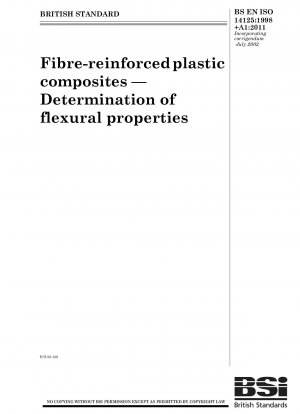BS EN ISO 14125:1998+A1:2011
Fibre-reinforced plastic composites. Determination of flexural properties
- Standard No.
- BS EN ISO 14125:1998+A1:2011
- Release Date
- 1998
- Published By
- British Standards Institution (BSI)
- Latest
- BS EN ISO 14125:1998+A1:2011
- Replace
- 94/342154 DC:1994 BS EN ISO 14125:1998
- Scope
- 1.1 This International Standard specifies a method for determining the flexural properties of fibre-reinforced plastic composites under three-point (Method A) and four-point (Method B) loading. Standard test specimens are defined but parameters included for alternative specimen sizes for use where appropriate. A range of test speeds is included. 1.2 The method is not suitable for the determination of design parameters, but may be used for screening materials, or as a quality-control test. NOTE For example, the flexural modulus is only an appropriate value of the tensile Young’s modulus of elasticity as the test is not for the additional deflection due to the shear stress which leads to a lower value of the flexural modulus but uses test span/specimen thickness ratios that minimise this effect. Differences between tensile and flexural properties are also caused by the material structure/lay-up. 1.3 The method is suitable for fibre-reinforced thermoplastic and thermosetting plastic composites. ISO 178, Plastics — Determination of flexural properties, applies to bulk compounds having fibres shorter than 7,5 mm. This is generally the case with materials intended for injection moulding. 1.4 The method is performed using specimens which may be moulded to the chosen dimensions, machined from the central portion of the standard multi-purpose test specimen (see ISO 3167) or machined from semi-finished or finished products such as mouldings or laminates. 1.5 The method specifies preferred dimensions for the specimen. Tests which are carried out on specimens of other dimensions, or on specimens which are prepared under different conditions, may produce results which are not comparable. Other factors, such as the speed of testing and the conditioning of the specimens can influence the results. For materials which are not homogeneous through the section, or above the linear-elastic response region, the result applies only to the thickness and structure tested. Consequently, when comparative data are required, these factors must be carefully controlled and recorded.
BS EN ISO 14125:1998+A1:2011 Referenced Document
- ISO 1268 Plastics; Preparation of glass fibre reinforced, resin bonded, low-pressure laminated plates or panels for test purposes
- ISO 178 Surface chemical analysis — Secondary ion mass spectrometry — Linearity of intensity scale in single ion counting time-of-flight mass analysers*, 2019-04-01 Update
- ISO 2602 Statistical interpretation of test results; estimation of the mean; confidence interval
- ISO 2818 Plastics — Preparation of test specimens by machining*, 2018-12-13 Update
- ISO 291 Plastics - Standard atmospheres for conditioning and testing*, 2008-05-01 Update
- ISO 293 Plastics — Compression moulding of test specimens of thermoplastic materials*, 2023-02-21 Update
- ISO 294-1 Plastics - Injection moulding of test specimens of thermoplastic materials - Part 1: General principles, and moulding of multipurpose and bar test specimens*, 2017-05-01 Update
- ISO 295 Plastics - Compression moulding of test specimens of thermosetting materials*, 2004-02-01 Update
- ISO 5893 Rubber and plastics test equipment — Tensile, flexural and compression types (constant rate of traverse) — Specification — Amendment 1*, 2020-09-21 Update
BS EN ISO 14125:1998+A1:2011 history
- 1998 BS EN ISO 14125:1998+A1:2011 Fibre-reinforced plastic composites. Determination of flexural properties
- 1998 BS EN ISO 14125:1998 Fibre-reinforced plastic composites - Determination of flexural properties
